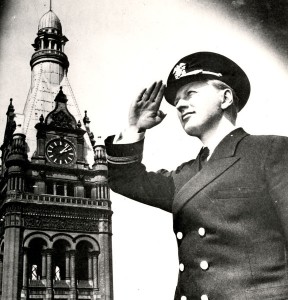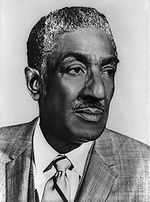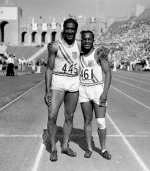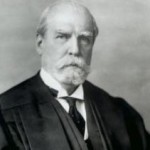The Singing Mayor from Marquette Law School
 Although his tenure as mayor was quite brief, Carl Frederick Zeidler (1908-1942) was one of the most colorful men ever to hold office as mayor of Milwaukee. He was also the most important Wisconsin public official to be killed in World War II.
Although his tenure as mayor was quite brief, Carl Frederick Zeidler (1908-1942) was one of the most colorful men ever to hold office as mayor of Milwaukee. He was also the most important Wisconsin public official to be killed in World War II.
Zeidler was born on January 4, 1908, in Milwaukee. His father, Michael Zeidler, had been born in Wisconsin in 1879, and was the son of a German and Austrian immigrants. His mother, Clare A. Zeidler, was one year younger than her husband and was also Wisconsin born. Her father was a native of Germany while her mother was born in New York state. Carl was the family’s first of four children. His father operated his own barber shop. The family was Lutheran, and, it appears, Republican.
Frank grew up in the Merrill Park section of Milwaukee and graduated from West Division High School. He attended Marquette University, receiving his undergraduate degree with honors in 1929 and his law degree in 1931. While at Marquette he ran the half-mile on the track team, participated in debate, played in the band, and was a member of several public speaking and singing societies. He was also a member of the Marquette Law Review. Upon graduation from law school, he relocated to Chicago where he practiced law until 1936, when he returned to Milwaukee to become an assistant city attorney. In the late 1930’s he was spectacularly successful as prosecutor, winning conviction after conviction of members of the pro-Nazi Bund. He also drafted, and successfully defended in court, the city’s first anti-pinball ordinance.
By all accounts Carl was an extremely gregarious and outgoing individual. His golden-haired good looks and powerful baritone singing voice gave him a charismatic quality that endeared him to almost everyone he met. He also had a penchant for joining social and fraternal organizations. By 1940, he was reportedly a member of 25 different Milwaukee organizations ranging from the YMCA to the Knights of Pythias. According to his younger brother Frank (himself a future Milwaukee mayor), “Carl had a drive and warmth that made him a political natural.” According to Time Magazine, Carl “gravitated toward people,” and claimed to know 50,000 Milwaukeeans by their first names.
In 1940, Carl Zeidler decided to challenge the city’s popular mayor Daniel Hoan who was seeking reelection to his seventh term. Hoan, a socialist, had a distinguished track record of integrity and accomplishment and few initially thought that Zeidler had any chance at all. Though nominally a Republican, the 32-year old Zeidler ran as a non-partisan independent, and his candidacy was nothing like anything previously seen in a Milwaukee election, particularly during the Great Depression. In a campaign managed by a trio of young Milwaukeeans, Jim Doolittle, Harold Gauer, and Robert Bloch (the author of Psycho), Zeidler concentrated more on capturing the attention of Milwaukee voters than he did on issues that separated him from Hoan. He regularly appeared with a five-piece band, beautiful women passing out campaign literature, an enormous American flag, and balloons that dropped from the ceiling at the end of indoor rallies. (This practice apparently originated with the Zeidler campaign.) Whenever possible, Zeidler would also break into song. While his favorite song was “God Bless America,” he was just as likely to burst into “I Love You Truly,” “Irish Eyes Are Smiling,” or some other popular song of that era. To appeal to Milwaukee’s broad mix of ethnic groups, he also sang in five different languages. Calling his campaign a crusade for “youth and Americanism,” he adopted the campaign slogan, “A new day for Milwaukee.” Although he challenged Hoan to a series of debates and criticized Hoan’s rigid building code as resulting in construction moving to the suburbs, it was Zeidler’s personality, not his stand on the issues, that drove his candidacy.
The April 2, 1940 Milwaukee mayoral election resulted in a record turnout of voters. To the surprise of many, Zeidler ousted Hoan from office by 12,000 votes, in spite of Hoan’s nearly flawless record of success as mayor. The key to Zeidler’s success was apparently a combination of his personal charisma and votes of Republicans and conservative Democrats who still considered Hoan a dangerous “Red” even after 24 years in office during which the city had flourished and even though he had dropped the Social label in 1936 in favor of being the candidate of the Wisconsin Farmer-Labor Progressive Federation.
The race captured national attention, and the Washington Post reported Zeidler’s upset victory with the observation: “Time takes its toll even of gratitude. The people of Athens got tired of hearing Aristides called the just and the people of Milwaukee apparently got tired of Daniel Webster Hoan for no better reason. Hoan, the Socialist, had nothing to offer them but a continuation of a satisfactory status quo.” The St. Petersburg (Fla.) Times carried the story of Zeidler’s election at the top of its front page under the headline: “Personality Kid—That’s Milwaukee’s New Blond, Baritone, Bachelor Mayor.” According to Zeidler himself, “I used nothing else than modern merchandising methods. See ’em, tell ’em, sell ’em.” Zeidler’s election at age 32 made him the nation’s youngest mayor and a figure of national interest.
One voter that Zeidler did not convince was his deeply religious brother Frank who had become a convert to socialism in 1933 and in 1940 served as the Milwaukee County Surveyor. The younger Zeidler supported his fellow Socialist Hoan over his brother, but after the election both Zeidler’s insisted that the election had not affected their relationship as brothers.
Now dubbed the “Singing Mayor,” Zeidler entered office on April 15 with the same flamboyance with which he had campaigned as he was sworn in before a crowd of 7,000 people in the Milwaukee Auditorium. As mayor, he continued the good government practices of his predecessor, but he did adopt more conservative fiscal policies including a lowering of property taxes and a reduction of the city payroll. With World War II already raging in Europe he also orchestrated the city’s efforts to prepare for what many viewed as the inevitable United States entry into the war. In a major coup for the city, he also succeeded in convincing the American Legion to hold its 1941 convention in Milwaukee. He also began the tradition immediately after his swearing in of flying the American flag over city hall every day.
By the second year of his term Zeidler was increasingly concerned with military matters. In September of 1941, he had accepted an honorary appointment as a captain in the Milwaukee state guard, but the satisfaction of an honorary appointment was short-lived. After Pearl Harbor, Zeidler became increasingly restless as mayor and grew anxious to be in combat himself. In February of 1942, he travelled to the Great Lakes Naval Training Station north of Chicago and applied for a commission in the Naval Reserve. He was given the rank of Lieutenant, j. g., and from mid-February on, Milwaukeeans knew that it was only a matter of time before he would resign as mayor.
In April he was called to active duty, and on April 16, just a day more than two years after his inauguration, Ziedler formally resigned. Although most Milwaukeeans considered Zeidler a good mayor, his decision to go into the military was widely applauded as patriotic and as an appropriate example for others. Over 20,000 people showed up to wish him goodbye when he left the city. Common Council President John L. Bohn assumed the duties of mayor for the remainder of Zeidler’s term.
Lt. Zeidler was assigned to be the gunnery officer on the S. S. LaSalle a merchant marine vessel used to transport war materials from the continental United States to military facilities abroad. His first assignment took him to the Caribbean where the LaSalle encountered a surfaced enemy submarine which was fired upon by Zeidler’s guns. Although the submarine disappeared in the resulting smoke, there was insufficient evidence to award the crew to consider it officially destroyed although enthusiastic press accounts speculated that the enemy vessel had been sunk. When Lt. Zeidler returned to Milwaukee on a 72 hour pass during the last week of August, he was treated as a returning hero. As luck would have it Zeidler arrived during State Fair Week and he was able to fill his short visit with a series of public speeches and singing opportunities.
Leaving Milwaukee, Zeidler returned for the east coast where the LaSalle embarked for the Canal Zone with a merchant crew of 40 and a gun crew of 18. From the Canal Zone, the ship was to carry military supplies, including airplanes, ammunition, and tanks to Cape Town, South Africa. When the ship departed from Balboa, Canal Zone, on September 26, its captain was under strict orders to maintain radio silence unless it was absolutely necessary to send a distress signal.
The 26th of September was the last day that the United States has any record of the LaSalle. The ship did not arrive in South Africa on November 1 as scheduled, nor did it appear in subsequent days. No distress call was ever received, and the names of the crew members did not appear on German or Japanese prisoner of war lists. Many in Milwaukee held on to the hope that they had been captured by a Japanese submarine and that they had not yet been returned to Japan. On December 17, 1942, the ship was officially declared missing.
Even though no evidence of the whereabouts of the ship or its crew surfaced in 1943, the Secretary of the Navy elected to maintain the “missing” classification until November 4, 1944, when Zeidler’s parents were notified that their son was now presumed to have died on November 2, 1942. An official announcement of the declaration of the fate of the LaSalle was made four days later. That same year Zeidler’s successor Bohn was elected to a four-year term as mayor on his own.
Once Zeidler was declared dead, Congressman Thad F. Wasielewski of Wisconsin’s 5th District announced that he would try to convince either the Navy or the Merchant Marine to name a ship after the former mayor. Wasielewski, who had been a college and law school classmate of Zeidler at Marquette—both graduated from the law school in 1931—expressed confidence that the Navy would be willing to name a destroyer escort after him. In September of 1945, Mayor Bohn, Zeidler’s successor, appealed to President Truman for a special investigation into the disappearance of Zeidler’s ship. In his appeal, which occurred after the surrender of Japan, Bohn mentioned that some Milwaukeeans, including Zeidler’s parents held out hope that he was still alive, but unreported. Although an investigation was order, no additional information was forthcoming.
More than three decades after the LaSalle disappeared its fate was finally determined. In 1975, the Milwaukee Journal reported that unofficial German submarine warfare records indicate that the LaSalle was sunk by a German submarine in the Indian Ocean, 350 miles southeast of the coast of South Africa at 10:50 p.m. on November 7, 1942. The ship was several days behind schedule at that point, and the German torpedo detonated explosives on board the LaSalle causing it to explode. The ship’s crew apparently had no opportunity to send out a distress call.
Although it appears that neither the Navy nor the Merchant Marine named a ship after Zeidler, the Singing Mayor was not forgotten. Zeidler Park in downtown Milwaukee was named in his honor, and in 1948, Carl Zeidler’s younger brother Frank was elected Mayor of Milwaukee as a Socialist, at least in part on the basis of his brother’s popularity. Carl was also memoralized with a cenotaph in Milwaukee’s Forest Home Cemetery. Frank Zeidler served as mayor until 1960, and lived in Milwaukee until his death in 2006.
It is tempting to speculate what might have happened in Wisconsin’s political history if Carl Zeidler had not entered the Navy or if he had returned to Milwaukee unharmed after the war. Had he remained in civilian life, he almost certainly would have been reelected as mayor in 1944. However, his popularity was such that as early as 1941, his name began to be mentioned as a possible candidate for higher office. The Wisconsin Republican Party enthusiastically claimed him as one of its own, and as early as 1942 there was talk of his running on the Republican ticket against incumbent United States Senator Robert LaFollette, Jr., in 1946. LaFollette, the son of the famous Wisconsin progressive “Fighting Bob” LaFollette, held office as a member of the Progressive Party. Although the LaFollette name was an extremely potent one in Wisconsin, Zeidler had already demonstrated his ability to knock off entrenched political figures. Moreover, in November 1940, LaFollette had defeated his Republican opponent Fred Clausen by only 4% of popular vote, and Ziegler would clearly have been a more formidable opponent than Clausen.
Had Carl Zeidler had been around in 1946, he almost certainly would have defeated the winner of the actual 1946 Republican primary, an obscure Fox Valley Appleton judge and Marquette Law School graduate named Joseph McCarthy. Had Zeidler not gone down with the LaSalle, not only might the history of the postwar Wisconsin have been affected, but the United States experience in the Cold War could also have turned out quite differently.
Photos of the first Mayor Zeidler can be found at http://content.mpl.org/cdm4/results.php?CISOOP1=any&CISOFIELD1=CISOSEARCHALL&CISOROOT=/MilwMayors&CISOBOX1=law



